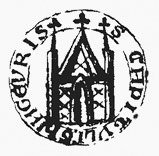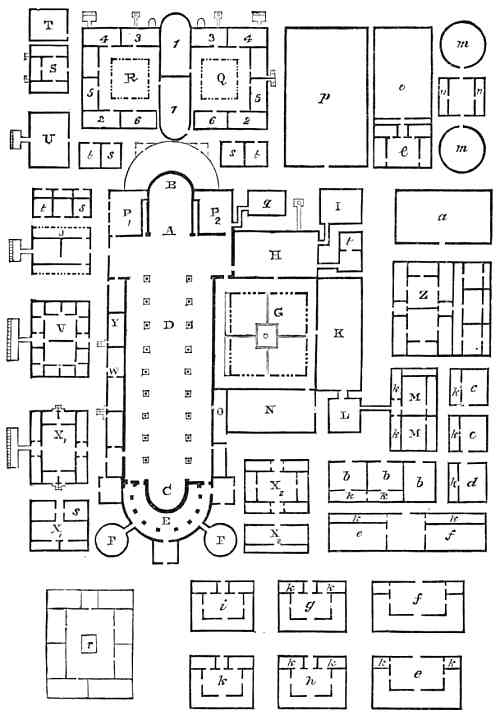|
Þingeyraklaustur
Þingeyraklaustur was a monastery of the Order of Saint Benedict located in Þingeyrar on Iceland from 1133 until 1551. It was the first monastery in Iceland and probably the last to be closed by the Icelandic Reformation. History The monastery was founded by bishop Jón Ögmundsson in 1106, but it was not inaugurated until 1133 when its first abbot, Vilmundur Þórólfsson, was officially installed in office. Jón Ögmundsson assured the monastery an income from all farms between Hrútafjörður and Vatnsdalsá. Þingeyraklaustur was one of the largest and richest monasteries in Iceland and a famous center of literature, culture and education, famed for its library. ArngrÃmr Brandsson, Karl Jónsson, Gunnlaugr Leifsson and Oddr Snorrason were all religious brothers at Þingeyraklaustur and active as writers, and the writer Styrmer KÃ¥resson is believed to have been educated there as well. A large number of Sagas of Icelanders were either produced or copied at the monast ... [...More Info...] [...Related Items...] OR: [Wikipedia] [Google] [Baidu] |
Þingeyrar
Þingeyrar (Thingøre in some older texts) is a farm in Iceland's Northwestern Region. It lies adjacent to the sandy coastal plain of Þingeyrasandur (or Thingøresand), between the Skagi and Vatnsnes peninsulas and just northeast of lake Hóp. Þingeyrar was formerly the location of the famous convent Þingeyraklaustur (1133–1551). It is also the site of Iceland's first stone church, Þingeyrakirkja. Icelandic scholar and politician Björn M. Ólsen (1850–1919) was born in Þingeyrar. Bjarni Halldórsson (–1773), an Icelandic legal figure and theologian, spent most of his life in Þingeyrar. One of the earliest recorded giant squid The giant squid (''Architeuthis dux'') is a species of deep-ocean dwelling squid A squid (: squid) is a mollusc with an elongated soft body, large eyes, eight cephalopod limb, arms, and two tentacles in the orders Myopsida, Oegopsida, ... (''Architeuthis dux'') specimens was found washed ashore on Þingeyrasandur in 1639.Vols ... [...More Info...] [...Related Items...] OR: [Wikipedia] [Google] [Baidu] |
1133 Establishments In Europe
Year 1133 ( MCXXXIII) was a common year starting on Sunday of the Julian calendar. Events By place Europe * Spring – A German expeditionary force, led by King Lothair III, marches into northern Italy, and arrives at Rome, after a 6-month journey across the Alps. Accompanied by Bernard of Clairvaux, French abbot and Doctor of the Church, Lothair is crowned by Pope Innocent II as Holy Roman Emperor at the Church of the Lateran, on June 4. He receives as papal fiefs the vast estates of Matilda, former margravine of Tuscany, which he secures for his daughter Gertrude of Süpplingenburg and her husband, Duke Henry X (the Proud) of Bavaria. * July 17 – Battle of Fraga: The Castellan troops led by King Alfonso I (the Battler) defeat the Almoravid army, thanks to a timely intervention of a Norman Crusader army from Tarragona, led by Robert Bordet. * Ramon Berenguer IV, count of Barcelona, launches a raid against Almoravid-held territories in Al-Andalus (mode ... [...More Info...] [...Related Items...] OR: [Wikipedia] [Google] [Baidu] |
ArngrÃmr Brandsson
ArngrÃmr Brandsson (died 13 October 1361) was an Icelandic cleric and writer. ArngrÃmr‘s early life and career has long been the subject of debate; the evidence for it is sometimes contradictory. The synthesis of the evidence by Jón Helgason is widely seen as the most convincing.Jón Helgason, 'Introduction', in Jón Helgason ed., ''Biskupa sÇ«gur: MS Perg. fol. No. 5 in the Royal Library of Stockholm'' (Copenhagen: Einar Munksgaard, 1950), pp. 15-21 (pp. 16-18), cited by Erika Ruth Sigurdson, 'The Church in Fourteenth-Century Iceland: Ecclesiastical Administration, Literacy, and the Formation of an Elite Clerical Identity' (unpublished Ph.D. thesis, University of Leeds, 2011), p. 58, http://etheses.whiterose.ac.uk/2610 In this account, ArngrÃmr was consecrated as a secular priest, held the benefice of Oddi, and served Bishop Jón Halldórsson of Skálholt. In 1341, he took holy orders, possibly in Þykkvibær. He certainly became abbot of the monastery of Þingeyraklaustur ... [...More Info...] [...Related Items...] OR: [Wikipedia] [Google] [Baidu] |
Gunnlaugr Leifsson
Gunnlaugr Leifsson (died 1218 or 1219) was an Icelandic scholar, author and poet. He was a Benedictine monk at the Þingeyraklaustur monastery (Icelandic ''Þingeyrarklaustur'') in the north of Iceland. Many sources (including ''Þorvalds þáttur vÃðförla'') refer to him simply as ''Gunnlaugr munkr'' or Gunnlaugr the Monk. Biography Little is known about Gunnlaugr's family or life, but a miracle in ''Jóns saga helga hin elsta'' describes how Gunnlaugr the Monk's "disciple and relative" Leifr recovers from a dangerous illness after drinking holy water touched by the relics of Bishop Jón Ögmundarson of Hólar. The miracle is dated to the episcopy of Guðmundur Arason of Hólar (between 1203 and 1237). Gunnlaugr composed a Latin biography of King Óláfr Tryggvason (see '' Óláfs saga Tryggvasonar''). This work is now lost but it is believed to have been an expansion of the Latin '' Óláfs saga Tryggvasonar'' written by his monastic brother, Oddr Snorrason. Snorri Stur ... [...More Info...] [...Related Items...] OR: [Wikipedia] [Google] [Baidu] |
Oddr Snorrason
Oddr Snorrason whose name is also sometimes Anglicized as Odd Snorrason was a 12th-century Icelandic Benedictine monk at the Þingeyraklaustur monastery (''Þingeyrarklaustur''). The monastery was founded in 1133 and was the first in Iceland. Work One Latin version of the ''Óláfs saga Tryggvasonar'' is attributed to Oddr – the original work has been almost completely lost but a translation into Old Norse is preserved in two nearly complete versions and a fragment of a third. Oddr made use of previous written works including those of Sæmundr fróði and Ari Þorgilsson as well as '' Acta sanctorum in Selio'' and possibly ''Historia de Antiquitate Regum Norwagiensium''. In turn Snorri Sturluson made use of Oddr's work when writing the ''Heimskringla'', as did the author of ''Óláfs saga Tryggvasonar en mesta''. ''Yngvars saga vÃðförla ''Yngvars saga vÃðförla'' (also known as ''Sagan om Ingwar Widtfarne och hans Son Swen'') is a legendary saga said to have been written ... [...More Info...] [...Related Items...] OR: [Wikipedia] [Google] [Baidu] |
HeiðarvÃga Saga
''HeiðarvÃga saga'' () or ''The Story of the Heath-Slayings'' is one of the Icelanders' sagas. It is badly preserved; 12 leaves of the only surviving manuscript were destroyed along with their only copy in the fire of Copenhagen in 1728. The content of the destroyed portion is only known through a summary written from memory by Icelandic scholar Jón GrunnvÃkingur (1705–1779). This is the only form in which the saga's contents survive today. The saga has been taken by some scholars as possibly among the oldest Icelanders' sagas. The saga tells of the descendants of Egil SkallagrÃmsson and the long-standing disputes and conflicts which culminated in the battle and subsequent slayings on the heath, the eponymous An eponym is a noun after which or for which someone or something is, or is believed to be, named. Adjectives derived from the word ''eponym'' include ''eponymous'' and ''eponymic''. Eponyms are commonly used for time periods, places, innovati ... Heath-Slayin ... [...More Info...] [...Related Items...] OR: [Wikipedia] [Google] [Baidu] |
Monasteries Dissolved Under The Icelandic Reformation
A monastery is a building or complex of buildings comprising the domestic quarters and workplaces of monastics, monks or nuns, whether living in communities or alone (hermits). A monastery generally includes a place reserved for prayer which may be a chapel, church, or temple, and may also serve as an oratory, or in the case of communities anything from a single building housing only one senior and two or three junior monks or nuns, to vast complexes and estates housing tens or hundreds. A monastery complex typically comprises a number of buildings which include a church, dormitory, cloister, refectory, library, balneary and infirmary and outlying granges. Depending on the location, the monastic order and the occupation of its inhabitants, the complex may also include a wide range of buildings that facilitate self-sufficiency and service to the community. These may include a hospice, a school, and a range of agricultural and manufacturing buildings such as a barn, a forge, or ... [...More Info...] [...Related Items...] OR: [Wikipedia] [Google] [Baidu] |
12th-century Establishments In Iceland
1 (one, unit, unity) is a number, numeral, and glyph. It is the first and smallest positive integer of the infinite sequence of natural numbers. This fundamental property has led to its unique uses in other fields, ranging from science to sports, where it commonly denotes the first, leading, or top thing in a group. 1 is the unit of counting or measurement, a determiner for singular nouns, and a gender-neutral pronoun. Historically, the representation of 1 evolved from ancient Sumerian and Babylonian symbols to the modern Arabic numeral. In mathematics, 1 is the multiplicative identity, meaning that any number multiplied by 1 equals the same number. 1 is by convention not considered a prime number. In digital technology, 1 represents the "on" state in binary code, the foundation of computing. Philosophically, 1 symbolizes the ultimate reality or source of existence in various traditions. In mathematics The number 1 is the first natural number after 0. Each natural number, ... [...More Info...] [...Related Items...] OR: [Wikipedia] [Google] [Baidu] |
Christian Monasteries Established In The 1130s
A Christian () is a person who follows or adheres to Christianity, a monotheistic Abrahamic religion based on the life and teachings of Jesus Christ. Christians form the largest religious community in the world. The words ''Christ'' and ''Christian'' derive from the Koine Greek title (), a translation of the Biblical Hebrew term ''mashiach'' () (usually rendered as ''messiah'' in English). While there are diverse interpretations of Christianity which sometimes conflict, they are united in believing that Jesus has a unique significance. The term ''Christian'' used as an adjective is descriptive of anything associated with Christianity or Christian churches, or in a proverbial sense "all that is noble, and good, and Christ-like." According to a 2011 Pew Research Center survey, there were 2.3 billion Christians around the world, up from about 600 million in 1910. Today, about 37% of all Christians live in the Americas, about 26% live in Europe, 24% live in sub-Saharan Africa, ab ... [...More Info...] [...Related Items...] OR: [Wikipedia] [Google] [Baidu] |
Helgi Höskuldsson
Helge or Helgi is a Scandinavian, German, and Dutch mostly male name. The name is derived from Proto-Norse ''Hailaga'' with its original meaning being ''dedicated to the gods''. For its Slavic version, see Oleg. Its feminine equivalent is Olga. Notable people with this name *Halga, legendary Danish king mentioned in ''Beowulf'' and in medieval Scandinavian sources * Helgi Hjörvarðsson, Scandinavian hero from ''Helgakviða Hjörvarðssonar'', in the ''Poetic Edda'' *Helgi Hundingsbane, Scandinavian hero who figures in the ''Völsunga saga'' and who has two poems in the ''Poetic Edda'' *Helgi Haddingjaskati, Swedish hero from ''Hrómundar saga Gripssonar'' *Helge (Danish king), 9th-century king *Helge Akre (1903–1986), Norwegian diplomat *Helge Bostrom (1894–1977), Canadian ice hockey player *Helge Dohrmann (1939–1989), Danish politician *Helge Jung (1886–1978), Swedish general *Helge von Koch (1870–1924), Swedish mathematician *Helge Larsen (1915–2000), Danish politi ... [...More Info...] [...Related Items...] OR: [Wikipedia] [Google] [Baidu] |


